$$ \hspace*{2 mm}\mathrm{1.1\kern3mmy = 2\ sin\ x\ − 1\kern2mm\ } $$
Vertikale translasie : q = minus; 1 and
Die grafiek wissel/ossileer/swaai om y = minus; 1.
amplitude = 2
maksimum = 2 − 1 = 1
minimum = − 2 − 1 = − 3
Periode = 360°
Die maksimum word bereik
by x = 90° en x = -270°
Die minimum word bereik
x = − 90° en x = 270°
 [ V 1.1 ]
[ V 1.1 ]
$$ \hspace*{2 mm}\mathrm{1.2\kern3mmy = 1 − 2 sin\ x\kern2mm\ } $$
Vertikale translasie : q = 1 and
Die grafiek wissel om y = 1.
amplitude = 2
maksimum = 2 + 1 = 3
minimum = − 2 + 1 = − 1
Periode = 360°
Die maksimum word bereik
by x = − 270° en x = 90°
Die minimum word bereik
by x = −270° en x = 90°
 [ V 1.2 ]
[ V 1.2 ]
$$ \hspace*{2 mm}\mathrm{1.3\kern3mmy = 2\ cos\ x\ − 1\kern2mm\ } $$
Vertikale translasie : q = − 1 and
Die grafiek wissel om y = − 1.
amplitude = 2
maksimum = 2 − 1 = 1
minimum = − 2 − 1 = − 3
Periode = 360°
Die maksimum word bereik
by x = − 360°; x = 0° en x = 360°
Die minimum word bereik
by x = −180° en x = 180°
 [ V 1.3 ]
[ V 1.3 ]
$$ \hspace*{2 mm}\mathrm{1.4\kern3mmy = 1 − 2\ cos\ x\kern2mm\ } $$
Vertikale translation : q = 1
Die grafiek swaai om y = 1.
amplitude = 2
maksimum = 3
minimum = − 1
Periode = 360°
Die maksimum word bereik
by x = − 180° en x = 180°
Die minimum word bereik
by x = −360°; x = 0° en x = 360°
 [ V 1.4 ]
[ V 1.4 ]
$$ \hspace*{2 mm}\mathrm{1.5\kern3mmy = sin\ (x − 30°)\kern2mm\ } $$
Vertikale translasie : q = 0
Die grafiek ossilleer om y = 0, die X-as.
amplitude = 1
max\ksimum = 1
minimum = − 1
Periode = 360°
Die maksimum word bereik
by x = − 240° en x = 120°
Die minimum word bereik
at x = −60°; x = 0° and x = 300°
 [ V 1.5 ]
[ V 1.5 ]
$$ \hspace*{2 mm}\mathrm{1.6\kern3mmy = sin\ (x + 60°)\kern2mm\ } $$
Vertikale translasie : q = 0
Die grafiek ossilleer om y = 0, die X-as.
amplitude = 1
maksimum = 1
minimum = − 1
Periode = 360°
Die maksimum word bereik
by x = − 330° en x = 300°
Die minimum word bereik
by x = −150°; en x = 210°
 [ V 1.6 ]
[ V 1.6 ]
$$ \hspace*{2 mm}\mathrm{1.7\kern3mmy = cos\ (x − 60°)\kern2mm\ } $$
Vertikale translasie : q = 0 and
Die grafiek wissel om y = 0, die X-as.
amplitude = 1
maksimum = 1
minimum = − 1
Periode = 360°
Die maksimum word bereik
by x = − 300° en x = 60°
Die minimum word bereik
by x = −120°; en x = 240°
 [ V 1.7 ]
[ V 1.7 ]
$$ \hspace*{2 mm}\mathrm{1.8\kern3mmy = cos\ (x + 30°)\kern2mm\ } $$
Vertikale translasie : q = 0
Die grafiek wissel om y = 0, die X-as.
amplitude = 1
maksimum = 1
minimum = − 1
Periode = 360°
Die maksimum word bereik
aby x = − 30° en x = 330°
Die minimum word bereik
by x = −210°; en x = 150°
 [ V 1.8 ]
[ V 1.8 ]
$$ \hspace*{2 mm}\mathrm{1.9\kern3mmy = 1 − sin x\kern2mm\ } $$
Vertikale translasie : q = 1
Die grafiek wissel om y = 1.
amplitude = 1
maksimum = 2
minimum = 0
Periode = 360°
Die maksimum word bereik by x = − 90°
Die minimum word bereik by x = 90°
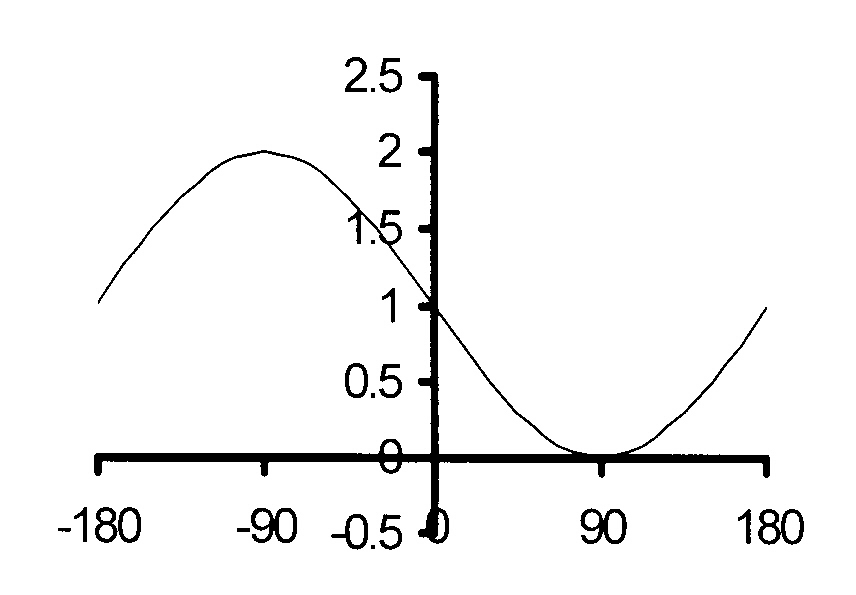 [ V 1.9 ]
[ V 1.9 ]
$$ \hspace*{2 mm}\mathrm{1.10\kern3mmy = 3\ cos\ x\ − 2\kern2mm\ } $$
Vertikale translasie : q = − 2
Die grafiek ossilleer om y = −2.
amplitude = 3
maksimum = 3 × 1 − 2 = 1
minimum = 3 × −1 − 2 = −5
Periode = 360°
Die maksimum word bereik by x = 0°
Die minimum word bereik
by x = − 180° en x = 180°
 [ V 1.1 ]
[ V 1.1 ]
$$ \hspace*{2 mm}\mathrm{1.11\kern3mmy = sin\ (x − 30°)\kern2mm\ } $$
Vertikale translasie : q = 0
Die grafiek wissel om y = 0, die X-as.
amplitude = 1
maksimum = 1
minimum = −1
Periode = 360°
Die maksimum word bereik by x = 60°
Die minimum word bereik by x = − 120°
 [ V 1.11 ]
[ V 1.11 ]
$$ \hspace*{2 mm}\mathrm{1.12\kern3mmy = cos\ (2x − 60°)\kern2mm\ } $$
$$ \hspace*{12 mm}\mathrm{y = cos\ 2(x − 30°)\kern2mm\ } $$
Vertikale translasie : q = 0
Die grafiek ossilleer om y = 0, die X-as.
amplitude = 1
maksimum = 1
minimum = −1
$$ \hspace*{9 mm}\mathrm{Periode\ = \Big(\frac{360}{2}\Big)^{°} = 180°\kern2mm\ } $$
Die maksimum word bereik
by x = −150° en x = 30°
Die minimum word bereik
by x = − 60° en x = 120°
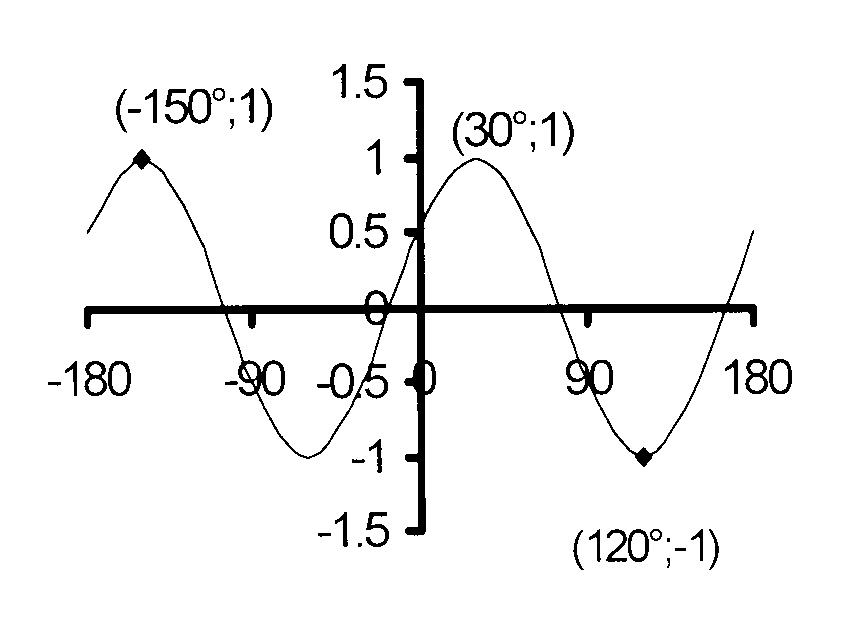 [ V 1.12 ]
[ V 1.12 ]
$$ \hspace*{2 mm}\mathrm{1.13\kern3mmy = cos\ (x + 30°)\ − 1\kern2mm\ } $$
Vertic\kale translasie : q = − 1
Die grafiek ossilleer om y = −1.
amplitude = 1
maksimum = 1 − 1 = 0
minimum = −1 −1 = −2
k = 1 en periode = 360°
Horisontale translasie : p = 30° na links
Die maksimum word bereik by x = −30°
Die minimum word bereik by x = 150°
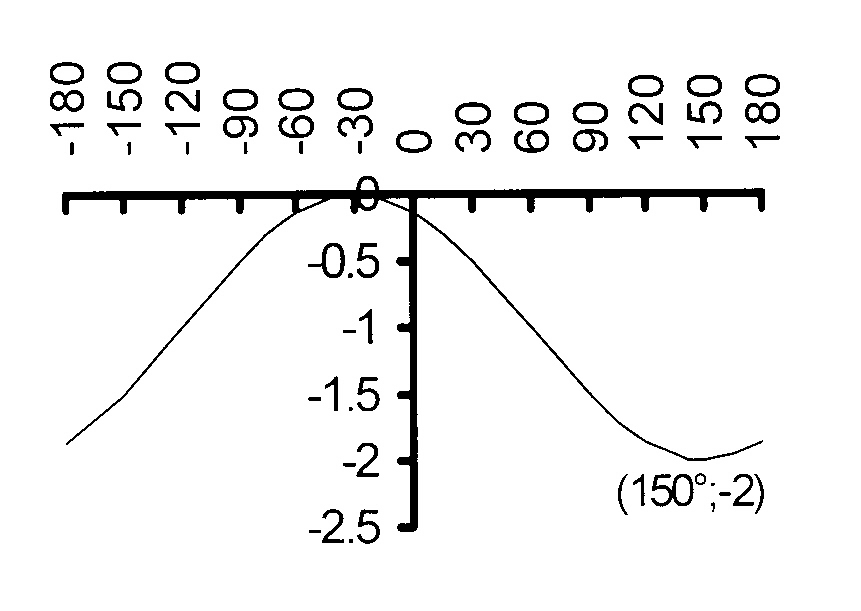 [ V 1.13 ]
[ V 1.13 ]
$$ \hspace*{2 mm}\mathrm{1.14\kern3mmy = sin\ (x + 60°)\ + 1\kern2mm\ } $$
Vertikale translasie : q = 1
Die grafiek wissel om y = 1.
amplitude = 1
maksimum = 1 + 1 = 2
minimum = 1 − 1 = 0
k = 1 en die periode = 360°
Horisontale verskuiwung : p = 60° na links
Die maksimum word bereik by x = 30°
Die minimum word bereik by x = −150°
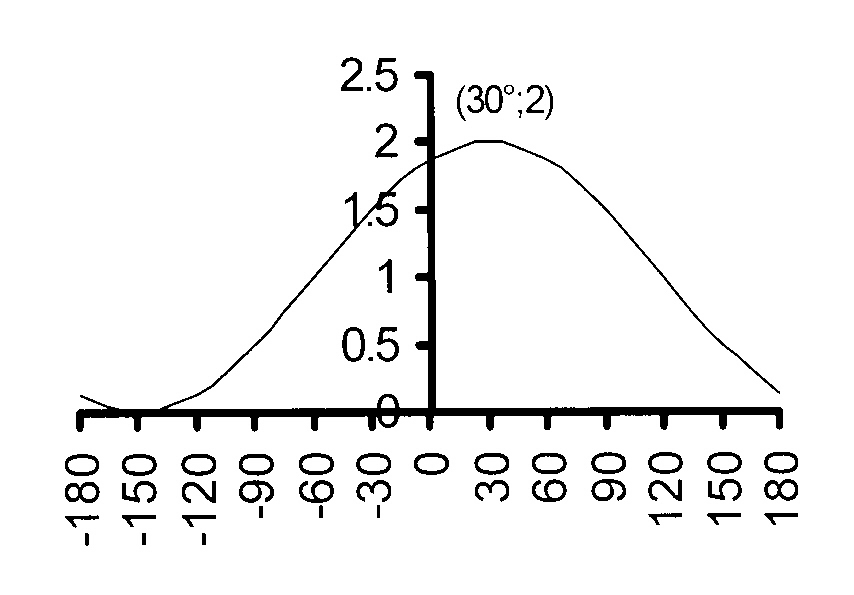 [ V 1.14 ]
[ V 1.14 ]
$$ \hspace*{2 mm}\mathrm{1.15\kern3mmy = tan\ x\kern2mm\ } $$
Asimptote by x = -90° en x = 90°
Periode = 180°
tan x = 1 by x = -135° en x = 45°.
tan x = − 1 by x = -45° en by x = 135°
Grafiek is stygend.
 [ V 1.15 ]
[ V 1.15 ]
$$ \hspace*{2 mm}\mathrm{1.16\kern3mmy = tan\ x +\ 1\kern2mm\ } $$
Asimptote by x = -90° en x = 90°
Periode = 180°
Vertikal verskuiwing : q = 1
tan x = 1 by x = 0°.
Grafiek is stygend.
 [ V 1.16 ]
[ V 1.16 ]
$$ \hspace*{2 mm}\mathrm{1.17\kern3mmy = tan\ (x + 30°)\kern2mm\ } $$
Asimptote by x = -120° en x = 60°
Periode = 180°
Vertikal translasie : q = 0
Horisontale verskuiwing : p = 30° na links
tan x = 1 by x = −165° ; x = 15°.
Grafiek is stygend.
 [ V 1.17 ]
[ V 1.17 ]
$$ \hspace*{2 mm}\mathrm{1.18\kern3mmy = tan\ 2x\kern2mm\ } $$
Asimptote by x = -45° en x = 45°
Periode = 90°
Vertikale translasie : q = 0
Horisontale verskuiwing : p = 0°
tan x = 1 by x = &inus;1650° en x = 150°.
Grafiek is stygend.
 [ V 1.18 ]
[ V 1.18 ]
2.1 The graph of y = a sin k(x + p)
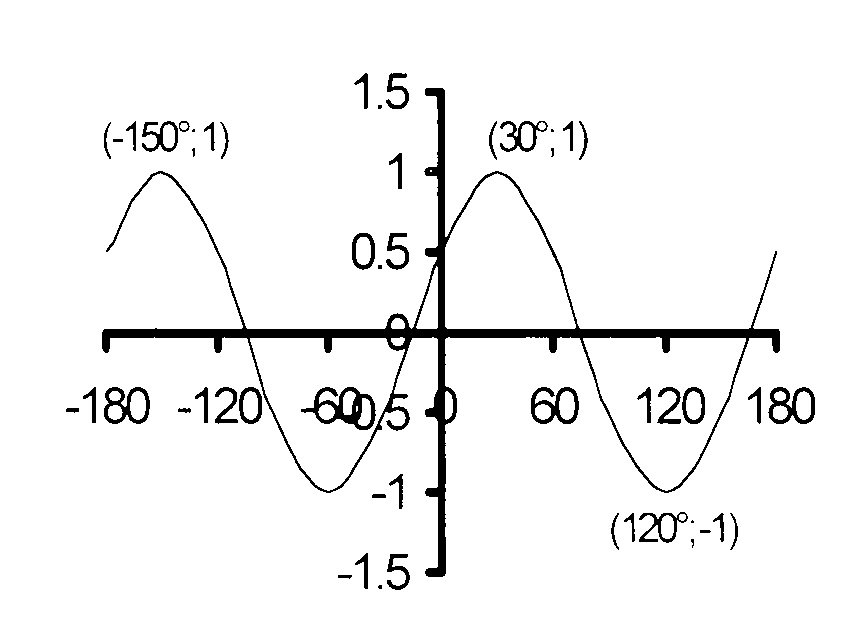
$$ \hspace*{2 mm}\mathrm{2.1\kern3mmy = a\ sin\ k(x + p)\ +\ q\kern2mm\ } $$
Die grafiek ossilleer om y = 0, die
X-as en dus q = 0..
Amplitude = 1 sodat a = 1.
$$ \hspace*{9 mm}\mathrm{periode\ = 180°\ en\ k = \Big(\frac{360°}{180°}\Big) = 2\kern2mm\ } $$
Horisontale translasie is 30° na links; p = +30°
Vergelyking : y = 1.sin 2x + 30°
= sin 2(x + 15)°
[ V 2.1 ]
$$ \hspace*{2 mm}\mathrm{2.2\kern3mmy = a\ cos\ k(x + p)\ +\ q\kern2mm\ } $$
Die grafiek wissel om y = 0, th\\die
X-axs en dus q = 0..
Amplitude = 1 sodat a = 1.
$$ \hspace*{9 mm}\mathrm{periode\ = 120°\ en\ k = \Big(\frac{360°}{120°}\Big) = 3\kern2mm\ } $$
Horisontale translasie is 30° na regs; p = − 30°
Vergelyking : y = 1.sin 2x − 30°
= sin 2(x − 15)°
[ V 2.2 ]
$$ \hspace*{2 mm}\mathrm{2.3\kern3mmy = a\ sin\ k(x + p)\ +\ q\kern2mm\ } $$
Die grafiek ossilleer om y = 0, die
X-axis en dus q = 0.
Amplitude = 2 sodat a = 2.
$$ \hspace*{9 mm}\mathrm{periode\ = 120°\ en\ k = \Big(\frac{360°}{120°}\Big) = 3\kern2mm\ } $$
By A(20° ; 0) : 3(20° + p) = 0°
60° + 3p = 0°
p = − 20°
Vergelyking : y = 2 sin 3(x − 20°)
[ V 2.3 ]
$$ \hspace*{2 mm}\mathrm{2.4\kern3mmy = a\ cos\ k(x + p)\ +\ q\kern2mm\ } $$
Die grafiek wissel om y = 0, die
X-as en dus q = 0..
Amplitude = 3 en die grafierk is 'n cosinus grafiek
sodat a = −3.
$$ \hspace*{9 mm}\mathrm{periode\ = 180°\ en\ k = \Big(\frac{360°}{180°}\Big) = 2\kern2mm\ } $$
By A(15° ; 0) : 2(15° + p) = 90°
30° + 2p = 90°
p = 30°
Vergelyking : y = − 3 cos 2(x + 30°)
[ V 2.4 ]
$$ \hspace*{2 mm}\mathrm{2.5\kern3mmy = a\ sin\ k(x + p)\ +\ q\kern2mm\ } $$
Die grafiek ossilleer om y = − 2,
en dus q = − 2.
Amplitude = 3 sodat a = 3.
Periode = 360° en k = 1
Daar is geen horisontale translasie nie en p = 0
Vergelyking : y = 3 sin (x + 0°) − 2
= 3 sin x − 2
[ V 2.5 ]
$$ \hspace*{2 mm}\mathrm{2.6\kern3mmy = a\ cos\ k(x + p)\ + q\kern2mm\ } $$
Die grafiek wissel om y = − 2,
en dus q = − 2.
Amplitude = 3 sodat a = 3.
$$ \hspace*{9 mm}\mathrm{periode\ = 180°\ en\ k = \Big(\frac{360°}{180°}\Big) = 2\kern2mm\ } $$
Daar is geen horisontale translasie en p = 0°
Vergelyking : y = 3 cos 2(x + 0°) − 2
= 3 cos 2x − 2
[ V 2.6 ]

3.1 A(− 150°;0); B(30°;0);
C(0;− 0,5)
[ V 3.1 ]
$$ \hspace*{2 mm}\mathrm{3.2\kern3mmperiod = 360°\kern2mm\ } $$
[ V 3.2 ]
$$ \hspace*{2 mm}\mathrm{3.3\kern3mmsin\ (x - 30°) = cos\ 2x\kern2mm\ } $$
$$ \hspace*{29 mm}\mathrm{= sin\ (90° − 2x)\kern2mm\ } $$
$$ \hspace*{17 mm}\mathrm{x − 30° = 2x + n.360°\kern2mm\ } $$
$$ \hspace*{26 mm}\mathrm{x = 40° + n.120°;\ \ n \isin Z\kern2mm\ } $$
$$ \hspace*{33 mm}\mathrm{\bold{OF}\kern2mm\ } $$
$$ \hspace*{17 mm}\mathrm{x − 30° = 180° − (90° − 2x) + n.360°\kern2mm\ } $$
$$ \hspace*{17 mm}\mathrm{x − 30° = 180° − 90° + 2x + n.360°\kern2mm\ } $$
$$ \hspace*{23 mm}\mathrm{− x = 120° + n.360°\kern2mm\ } $$
$$ \hspace*{24 mm}\mathrm{ x = −120° − n.360°\kern2mm\ } $$
Oplossing : x = 40°−1.120° ; 40° + 0.120° ;
x = 40° + 1.120° and − 120° − 0.360°;
Oplossing : x = − 80°(E); 40°(F); 160°(G) ; − 120°(D)
[ V 3.3 ]
$$ \hspace*{2 mm}\mathrm{3.4\kern3mmf(x) < − 0,5\ \ as\ − 120° < x < 0°\kern2mm\ } $$
[ V 3.4 ]
$$ \hspace*{2 mm}\mathrm{3.5\kern3mmf(x) ≥ 0,5\ \ as\ 60° ≤ x ≤ 180°\kern2mm\ } $$
[ V 3.5 ]
4.1 f: amplitude = 2 en dus a = 2
Die kosinusgrafiek bereik 0 by 60° in plaas
van by 90° sodat die grafiek dus 30° na links
verskuif is en dus b = 30°
Die sinusgrafiek, g, ossilleer om y = 1
sodat c = 1
$$ \hspace*{8 mm}\mathrm{periode = 180°\ en\ dus\ d = \Big(\frac{360°}{180°}\Big) = 2\kern2mm\ } $$
[ V 4.1 ]
$$ \hspace*{2 mm}\mathrm{4.2\kern3mmf(x) = 2\ cos\ (x − 30°)\kern2mm\ } $$
$$ \hspace*{10 mm}\mathrm{f(0) = 2\ cos\ (0 + 30°)\kern2mm\ } $$
$$ \hspace*{16 mm}\mathrm{= 2\ cos\ 30°\kern2mm\ } $$
$$ \hspace*{16 mm}\mathrm{= 2\Big(\frac{\sqrt3}{2}\Big) = \sqrt3\kern2mm\ } $$
[ V 4.2 ]
4.3.1 f: x = 45° en x = −135°
[ V 4.3.1 ]
4.3.2 f en g kruis by (−90° ; 1) en
by (13,5° ; 1,45): dus die oplossing :
−90° ≤ x ≤ 13,5°
[ V 4.3.2 ]
4.4 f(x) bereik sy maksimum by − 30°.
Die as is dus 30° na links verskuif,
d.i die grafiek is 30° na regs verskuif
en p = 30°
$$ \hspace*{10 mm}\mathrm{f(x) = 2 cos (x − 30°)\kern2mm\ } $$
$$ \hspace*{10 mm}\mathrm{f(x) = 2 cos (x + 30° − 30°)\kern2mm\ } $$
$$ \hspace*{10 mm}\mathrm{f(x) = 2 cos x\kern2mm\ } $$
[ V 4.4 ]
5.1 f: amplitude = 1 en dus a = 1
Die kosinusgrafiek bereik 1 by 30° i.p.v.
0° sodat die grafiek 30° na regs
verskuif is en dus b = −30°
Die sinusgrafiek, g, het 'n periode = 360°
sodat c = 1
[ V 5.1 ]
$$ \hspace*{2 mm}\mathrm{5.2.1\kern3mmOmvang\ :\ −0,5 \le y \le 1\kern2mm\ } $$
[ V 5.2.1 ]
$$ \hspace*{2 mm}\mathrm{5.2.2\kern3mm30° < x \le 90°\kern2mm\ } $$
[ V 5.2.2 ]
$$ \hspace*{2 mm}\mathrm{5.2.3\kern3mmOmvang : −90° ≤ x ≤ −60°\ \ en\ \ x = 0°\kern2mm\ } $$
[ Q 5.2.3 ]
$$ \hspace*{2 mm}\mathrm{5.3\kern3mmcos\ (x − 30°)\ =\ sin\ x\kern2mm\ } $$
$$ \hspace*{31 mm}\mathrm{= cos\ (90° − x)\kern2mm\ } $$
$$ \hspace*{16 mm}\mathrm{\therefore x − 30° = 90° − x + n\bold{.}360°\ \kern3mm\ n ∈ Z\kern2mm\ } $$
$$ \hspace*{23 mm}\mathrm{\therefore 2x = 120° + n\bold{.}360°\kern2mm\ } $$
$$ \hspace*{25 mm}\mathrm{\therefore x = 60° + n\bold{.}180°\kern2mm\ } $$
$$ \hspace*{25 mm}\mathrm{\therefore x = 60°\kern2mm\ } $$
As g(x) > f(x) dan 60° < x ≤ 90°
[ V 5.3 ]
5.4 Die grafiek van g(x) is 60° na links
verskuif en dus verander x na x + 60°
$$ \hspace*{10 mm}\mathrm{g(x) = sin x\kern2mm\ } $$
$$ \hspace*{10 mm}\mathrm{h(x) = sin (x + 60°)\kern2mm\ } $$
[ V 5.4 ]
5.5 f(x) moet 60° na regs verskuif word
om g(x) te vorm.
[ V 5.5 ]
6.1 Amplitude = 2 en dus c = 2
periode = 360° en dus d = 1.
[ V 6.1 ]
6.2 Amplitude = 1 en dus a = 1;
f(60°) = 1 en dus is die grafiek 60° na regs
verskuif sodat b = − 60°
[ V 6.2 ]
6.3 Reikwydte : − 2 ≤ y ≤ 2
[ V 6.3 ]
6.4 −120° ≤ x ≤ − 30°
[ V 6.4 ]
6.5 Die Y-as is 30° na links verskuif sodat die
oorspronklike sinusgrafiek 30° na regs
verskuif is en x verander na x − 30°
y = 2 sin x word y = 2 sin (x − 30°).
[ V 6.5 ]
7.1 Die grafiek van sin x = 0 by 0°
g(x) = 0 by − 30°. g(x) is dus 30° na links
verskuif en dus b = 30°.
[ V 7.1 ]
7.2 Periode = 360°
[ V 7.2 ]
7.3 f(x) − g(x) = 0 by x = − 150° en
x = 30°:
[ V 7.3 ]
7.4.1 sin (90° − x) = cos x, dus f(x) > g(x)
x ∈ (− 150° ; 30°)
[ V 7.4.1 ]
7.4.2 Vir f(x)
.g(x) < 0, moet f(x) en g(x) verskillende
tekens hê. f(x) < 0 as x < − 90° en
g(x) < 0 as x < − 30°. Dus f(x) en g(x) het
verskillende tekens as −90° < x < −30°.
Dus f(x)
.g(x) < 0 as −90° < x < −30°.
[ V 7.4.2 ]
7.4.3 f(x)
.g(x) ≥ 0 as −180° ≤ x ≤ −90° en
−30° ≤ x ≤ 90°.
[ V 7.4.3 ]
7.5 f(x) het 'n minimum van − 1 en 'n maksimum
van 1. Alle y-waardes word met 3 vermeerder,
sodat die reikwydte of omvang
-1+3 ≤ y ≤ 1+3, d.i. 2 ≤ y ≤ 4.
[ V 7.5 ]
7.6 f(x) word 3 eenhede afwaarts verskuif, sodat
y = 0 − 3 = − 3. p(x) = cos x − 3
[ V 7.6 ]
7.7 f(x) word 30° na links verskuif, sodat
p = 30°. Dus q(x) = cos (x − 30°)
[ V 7.7 ]



















